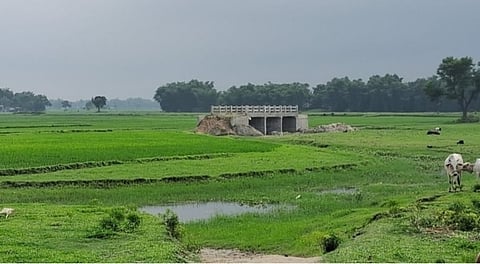Can Bihar Become a Hub for Textiles and Electronics? Exploring the Scope for Labor-Intensive Industries
Agro-Based Industries Most Suitable for Bihar: Harnessing the State’s Agricultural Potential
Manoj Bharti: Diplomat Turned Political Leader and Working President of Jan Suraaj Party
Bihar Assembly Election 2025: High-Stakes Battle Among NDA, Mahagathbandhan, and Jan Suraaj
Bihar: Land Reform That Pays for Itself
A Flourishing Bihar Through Inclusive Land Reform: The Case for Redistribution
Game Changers for Bihar: A Bold Vision for Transformation
Creating Massive Private Sector Jobs Across Bihar: The Prashant Kishor Formula
Data Colonization
A Concrete Five-Year Plan for Bihar
Prashant Kishor Must Be Jan Suraaj’s CM Candidate
Prashant Kishor: Bihar 2025
Can Meritocracy and Multiparty Democracy Coexist? Rethinking Elections for a Data-Driven Era
The Meritocratic Governance Party (MGP)
China: Meritocracy? Autocracy?
Land Reform Is the Magic Bullet for Bihar’s Future
Bihar stands at the crossroads of potential transformation. With its rich historical legacy, fertile land, and hardworking population, the state has everything it needs to become an engine of economic growth—not just for itself, but for all of India. But there’s one foundational reform that could truly unlock this potential: land reform.
Contrary to the myths and fears often associated with land reform, this is not a call for class war or arbitrary redistribution. It is a call for common prosperity, rooted in modern technology, inclusive economic logic, and a clear vision for a new Bihar.
The Core Argument: Why Land Reform Makes Everyone Richer
Let’s take a hypothetical but plausible case.
Suppose your family owns 50 bighas of land in Bihar. Currently, land prices are about ₹30 lakh per bigha. That gives you a total land value of ₹15 crore. After land reform, let’s say the ceiling is set and excess land is redistributed. Now you’re left with 25 bighas, but because of reforms and the rapid development that follows—such as the arrival of roads, electricity, 5G, factories, and digital infrastructure—the land value jumps to ₹70 lakh per bigha.
Now your total land value is ₹17.5 crore. You’ve just become wealthier with less land. Why? Because development drives up the price of land, and land reform paves the way for equitable, broad-based development. And this isn’t just about valuation—the land becomes far more productive, generating higher income from rentals, partnerships, or commercial use.
That’s the win-win magic of smart, well-implemented land reform.
The Pillars of Bihar’s Land Revolution
1. Satellite-Based Land Digitization
Use satellite imagery and geospatial technologies to digitally demarcate every parcel of land in Bihar with precise coordinates. This reduces disputes, eliminates encroachments, and brings clarity.
2. Aadhaar-Linked Ownership
Every plot of land must be Aadhaar-linked, ensuring transparency and clear title. This will help banks confidently extend credit to landowners using land as collateral. Landless families who receive land can now start businesses, send their children to school, and break the cycle of poverty.
3. Universal Land Access
A goal must be set so every family owns at least a small parcel of land. This is not about hurting landowners—it’s about ensuring that everyone has a stake in the economy, and everyone contributes to and benefits from development.
Why It Works: Global and Indian Examples
West Bengal (India)
In the 1970s and 1980s, land reform under Operation Barga dramatically increased agricultural productivity and reduced rural inequality. Sharecroppers were given rights, which incentivized better cultivation. West Bengal’s rural poverty fell rapidly during this period.
South Korea
Post-war South Korea implemented bold land reform under U.S. guidance. By redistributing land to tenant farmers and formalizing titles, South Korea not only eliminated feudalism but also laid the foundation for its rapid industrialization and rise to a high-income country.
Japan
After World War II, Japan’s land reform broke the power of large landlords and turned tenants into independent farmers. This created a new middle class and helped Japan avoid the social unrest seen in many other Asian countries.
Taiwan
Taiwan’s land-to-the-tiller program gave tenant farmers full ownership of land. The result? Explosive agricultural growth and the release of rural surplus labor to support Taiwan’s tech revolution.
These examples show that land reform is not about class conflict—it’s about creating the conditions for rapid economic takeoff.
Beyond Land: Building Bihar’s Digital and Knowledge Economy
While roads, bridges, and electricity are foundational, universal 5G access is now even more critical. Why? Because Bihar must leapfrog into the knowledge economy.
Just as Silicon Valley grew out of Stanford and San Francisco, “Silicon Ganga” can rise in Patna. With universal 5G, digital platforms can emerge that connect Bihari youth to the world—sending yoga teachers, tutors, coders, and artisans abroad virtually.
Online Work from Home – Ghar Baithe Baithe
-
A teacher in Bhagalpur can tutor a child in Boston.
-
A yoga instructor in Siwan can run a global wellness course.
-
A coder in Gaya can freelance for a startup in Berlin.
All this requires digital skills and connectivity, and both start with land security. Secure, documented land allows families to invest in education, health, and home-based business setups.
Conclusion: Land Reform Is Not Optional—It’s Urgent
Bihar’s story must change. Land reform is not about taking from one and giving to another—it’s about unlocking the economic potential trapped in inequality, uncertainty, and fragmentation.
It’s about turning Bihar’s millions of landless into entrepreneurs.
It’s about creating prosperity from the bottom up, not waiting for trickle-down.
It’s about a Bihar where land becomes the launchpad for a knowledge economy, where “Silicon Ganga” thrives, and where every family has not just dignity, but also opportunity.
Let land reform be the magic bullet that sparks Bihar’s true renaissance.
भूमि सुधार: बिहार के उज्ज्वल भविष्य की जादुई चाबी
बिहार एक ऐसे मोड़ पर खड़ा है जहाँ से वह एक बड़े बदलाव की ओर बढ़ सकता है। अपनी समृद्ध ऐतिहासिक विरासत, उपजाऊ भूमि और मेहनती जनसंख्या के साथ, राज्य के पास वह सब कुछ है जो इसे भारत के विकास इंजन में बदल सकता है। लेकिन इस परिवर्तन की सबसे बुनियादी शर्त है — भूमि सुधार।
भूमि सुधार को लेकर अक्सर जो डर और गलतफहमियाँ फैलाई जाती हैं, वे तथ्य से परे हैं। यह कोई वर्ग-संघर्ष नहीं है और न ही जबरन संपत्ति छीनने का प्रस्ताव। यह एक साझा समृद्धि की सोच है, जो आधुनिक तकनीक, समावेशी आर्थिक तर्क और बिहार के नव निर्माण के स्पष्ट दृष्टिकोण पर आधारित है।
मुख्य तर्क: भूमि सुधार सभी को अधिक समृद्ध बनाता है
मान लीजिए आपके परिवार के पास 50 बीघा ज़मीन है। अभी इस ज़मीन की कीमत ₹30 लाख प्रति बीघा है। इसका मतलब आपकी कुल ज़मीन की कीमत ₹15 करोड़ है। अब अगर भूमि सुधार लागू होता है और अधिकतम स्वामित्व सीमा तय की जाती है, तो आपकी ज़मीन घटकर 25 बीघा रह जाती है। लेकिन भूमि सुधार के बाद जैसे ही विकास की लहर चलती है — सड़कें बनती हैं, फैक्ट्रियाँ आती हैं, डिजिटल कनेक्टिविटी और 5G पहुँचता है — ज़मीन की कीमत बढ़कर ₹70 लाख प्रति बीघा हो जाती है।
अब आपकी कुल ज़मीन की कीमत ₹17.5 करोड़ हो गई है — कम ज़मीन के साथ भी आप पहले से अधिक संपन्न हैं। क्यों? क्योंकि विकास ज़मीन की कीमत बढ़ाता है और भूमि सुधार समावेशी विकास का रास्ता खोलता है।
और यह केवल कीमत की बात नहीं है — आपकी ज़मीन अब पहले से अधिक उत्पादक बन गई है, जिससे आपकी आमदनी भी बढ़ती है।
बिहार में भूमि क्रांति के तीन स्तंभ
1. सैटेलाइट तकनीक से भूमि का डिजिटलीकरण
उपग्रह और भौगोलिक तकनीकों के ज़रिए हर एक ज़मीन का सटीक सीमांकन और डिजिटलीकरण किया जाए। इससे विवाद घटेंगे, अतिक्रमण रुकेगा और स्वामित्व स्पष्ट होगा।
2. आधार से जुड़ा ज़मीन स्वामित्व
हर ज़मीन का स्वामित्व आधार कार्ड से जोड़ा जाए ताकि पारदर्शिता बनी रहे। इससे बैंक ज़मीन को बंधक मानकर ऋण देने में सक्षम होंगे। जिन परिवारों को ज़मीन मिलेगी, वे अब बिजनेस शुरू कर सकते हैं, बच्चों को स्कूल भेज सकते हैं, और गरीबी के चक्र को तोड़ सकते हैं।
3. हर परिवार को ज़मीन का अधिकार
एक स्पष्ट लक्ष्य हो — हर परिवार के पास कम से कम एक छोटा भूखंड हो। यह ज़मींदारों को नुकसान पहुँचाने की योजना नहीं है, बल्कि एक ऐसी व्यवस्था है जहाँ हर नागरिक की अर्थव्यवस्था में हिस्सेदारी हो और सबको विकास का लाभ मिले।
दुनिया और भारत से प्रेरणाएँ
पश्चिम बंगाल (भारत)
1970–80 के दशक में ‘ऑपरेशन बर्गा’ के तहत ज़मींदारी व्यवस्था खत्म कर बटाईदारों को अधिकार दिए गए। इससे कृषि उत्पादन और ग्रामीण आय में बड़ी वृद्धि हुई।
दक्षिण कोरिया
द्वितीय विश्व युद्ध के बाद वहाँ भूमि सुधार के ज़रिए ज़मींदारी को समाप्त किया गया और किसानों को ज़मीन दी गई। यह सुधार औद्योगीकरण की नींव बना।
जापान
युद्ध के बाद ज़मीन पुनर्वितरण ने किसानों को स्वतंत्र बनाया, जिससे एक नया मध्यम वर्ग बना और सामाजिक अस्थिरता टली।
ताइवान
'भूमि किसान को' योजना के अंतर्गत किसानों को ज़मीन का स्वामित्व दिया गया। इससे कृषि विकास में उछाल आया और देश ने टेक्नोलॉजी सेक्टर में क्रांति की।
इन सभी उदाहरणों से स्पष्ट है कि भूमि सुधार सामाजिक न्याय के साथ-साथ आर्थिक समृद्धि का ज़रिया बन सकता है।
आगे की राह: डिजिटल और ज्ञान आधारित बिहार
सड़कें और पुल जरूरी हैं, लेकिन आज के दौर में यूनिवर्सल 5G कनेक्टिविटी उससे भी अधिक जरूरी है। क्यों? क्योंकि बिहार को सीधे ज्ञान आधारित अर्थव्यवस्था में छलांग लगानी चाहिए।
जैसे अमेरिका में सिलिकॉन वैली उभरा, वैसे ही “सिलिकॉन गंगा” पटना से उभर सकता है। जहाँ डिजिटल प्लेटफ़ॉर्म के ज़रिए बिहारी युवा दुनिया भर से जुड़ सकें — योग शिक्षक, ट्यूटर, कोडर और शिल्पकार ऑनलाइन काम कर सकें।
घर बैठे काम — "घर बैठे-बैठे दुनिया से जुड़ाव"
-
भागलपुर का शिक्षक बोस्टन के बच्चे को पढ़ाए।
-
सिवान का योग प्रशिक्षक वैश्विक क्लास ले।
-
गया का कोडर बर्लिन की कंपनी के लिए काम करे।
इसके लिए ज़रूरी है — सुरक्षित ज़मीन का स्वामित्व, ताकि परिवार शिक्षा और डिजिटल व्यवसायों में निवेश कर सकें।
निष्कर्ष: भूमि सुधार विकल्प नहीं, ज़रूरत है
बिहार की कहानी को अब बदलना होगा। भूमि सुधार कोई कट्टरपंथी नीति नहीं है — यह एक आर्थिक क्रांति का आधार है।
यह सिर्फ संपत्ति नहीं देता, यह आत्मसम्मान और अवसर देता है।
यह केवल ज़मीन नहीं देता, यह भविष्य देता है।
अब वक्त है कि हम भूमि सुधार को बिहार की पुनर्जागरण यात्रा की शुरुआत बनाएं।
आइए, भूमि को अधिकार नहीं, अवसर बनाएं — और एक नए बिहार की नींव रखें।

